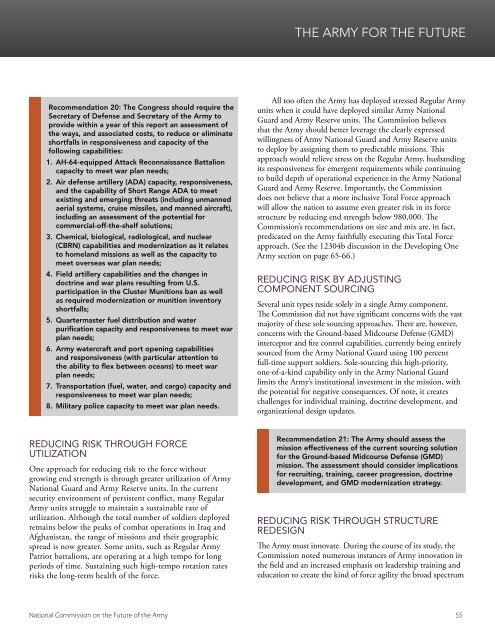THE FUTURE OF THE ARMY
Futurearmy
Futurearmy
You also want an ePaper? Increase the reach of your titles
YUMPU automatically turns print PDFs into web optimized ePapers that Google loves.
<strong>THE</strong> <strong>ARMY</strong> FOR <strong>THE</strong> <strong>FUTURE</strong><br />
Recommendation 20: The Congress should require the<br />
Secretary of Defense and Secretary of the Army to<br />
provide within a year of this report an assessment of<br />
the ways, and associated costs, to reduce or eliminate<br />
shortfalls in responsiveness and capacity of the<br />
following capabilities:<br />
1. AH-64-equipped Attack Reconnaissance Battalion<br />
capacity to meet war plan needs;<br />
2. Air defense artillery (ADA) capacity, responsiveness,<br />
and the capability of Short Range ADA to meet<br />
existing and emerging threats (including unmanned<br />
aerial systems, cruise missiles, and manned aircraft),<br />
including an assessment of the potential for<br />
commercial-off-the-shelf solutions;<br />
3. Chemical, biological, radiological, and nuclear<br />
(CBRN) capabilities and modernization as it relates<br />
to homeland missions as well as the capacity to<br />
meet overseas war plan needs;<br />
4. Field artillery capabilities and the changes in<br />
doctrine and war plans resulting from U.S.<br />
participation in the Cluster Munitions ban as well<br />
as required modernization or munition inventory<br />
shortfalls;<br />
5. Quartermaster fuel distribution and water<br />
purification capacity and responsiveness to meet war<br />
plan needs;<br />
6. Army watercraft and port opening capabilities<br />
and responsiveness (with particular attention to<br />
the ability to flex between oceans) to meet war<br />
plan needs;<br />
7. Transportation (fuel, water, and cargo) capacity and<br />
responsiveness to meet war plan needs;<br />
8. Military police capacity to meet war plan needs.<br />
All too often the Army has deployed stressed Regular Army<br />
units when it could have deployed similar Army National<br />
Guard and Army Reserve units. The Commission believes<br />
that the Army should better leverage the clearly expressed<br />
willingness of Army National Guard and Army Reserve units<br />
to deploy by assigning them to predictable missions. This<br />
approach would relieve stress on the Regular Army, husbanding<br />
its responsiveness for emergent requirements while continuing<br />
to build depth of operational experience in the Army National<br />
Guard and Army Reserve. Importantly, the Commission<br />
does not believe that a more inclusive Total Force approach<br />
will allow the nation to assume even greater risk in its force<br />
structure by reducing end strength below 980,000. The<br />
Commission’s recommendations on size and mix are, in fact,<br />
predicated on the Army faithfully executing this Total Force<br />
approach. (See the 12304b discussion in the Developing One<br />
Army section on page 65-66.)<br />
REDUCING RISK BY ADJUSTING<br />
COMPONENT SOURCING<br />
Several unit types reside solely in a single Army component.<br />
The Commission did not have significant concerns with the vast<br />
majority of these sole sourcing approaches. There are, however,<br />
concerns with the Ground-based Midcourse Defense (GMD)<br />
interceptor and fire control capabilities, currently being entirely<br />
sourced from the Army National Guard using 100 percent<br />
full-time support soldiers. Sole-sourcing this high-priority,<br />
one-of-a-kind capability only in the Army National Guard<br />
limits the Army’s institutional investment in the mission, with<br />
the potential for negative consequences. Of note, it creates<br />
challenges for individual training, doctrine development, and<br />
organizational design updates.<br />
REDUCING RISK THROUGH FORCE<br />
UTILIZATION<br />
One approach for reducing risk to the force without<br />
growing end strength is through greater utilization of Army<br />
National Guard and Army Reserve units. In the current<br />
security environment of persistent conflict, many Regular<br />
Army units struggle to maintain a sustainable rate of<br />
utilization. Although the total number of soldiers deployed<br />
remains below the peaks of combat operations in Iraq and<br />
Afghanistan, the range of missions and their geographic<br />
spread is now greater. Some units, such as Regular Army<br />
Patriot battalions, are operating at a high tempo for long<br />
periods of time. Sustaining such high-tempo rotation rates<br />
risks the long-term health of the force.<br />
Recommendation 21: The Army should assess the<br />
mission effectiveness of the current sourcing solution<br />
for the Ground-based Midcourse Defense (GMD)<br />
mission. The assessment should consider implications<br />
for recruiting, training, career progression, doctrine<br />
development, and GMD modernization strategy.<br />
REDUCING RISK THROUGH STRUCTURE<br />
REDESIGN<br />
The Army must innovate. During the course of its study, the<br />
Commission noted numerous instances of Army innovation in<br />
the field and an increased emphasis on leadership training and<br />
education to create the kind of force agility the broad spectrum<br />
National Commission on the Future of the Army 55


